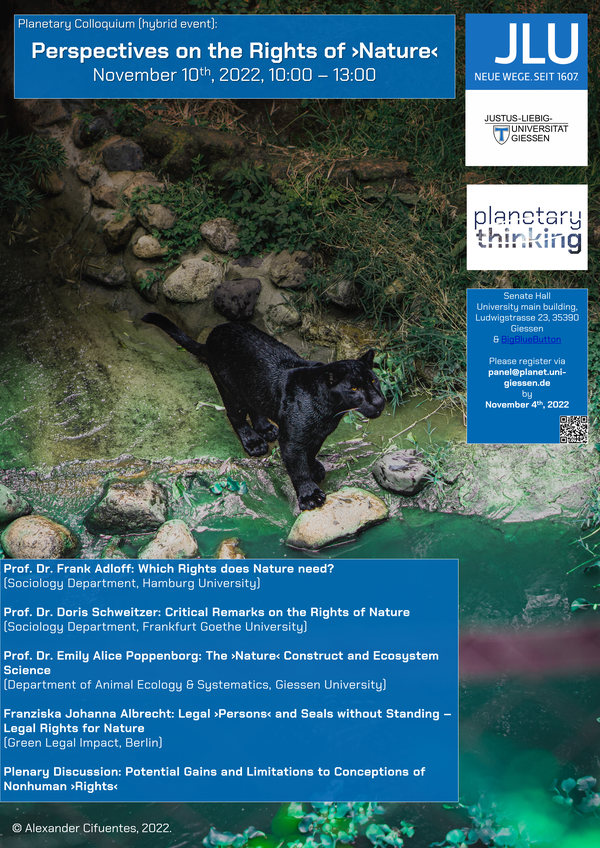Event Reports
Reflections: Planetary Materials-Workshop Series 18 October - 12 November 2022
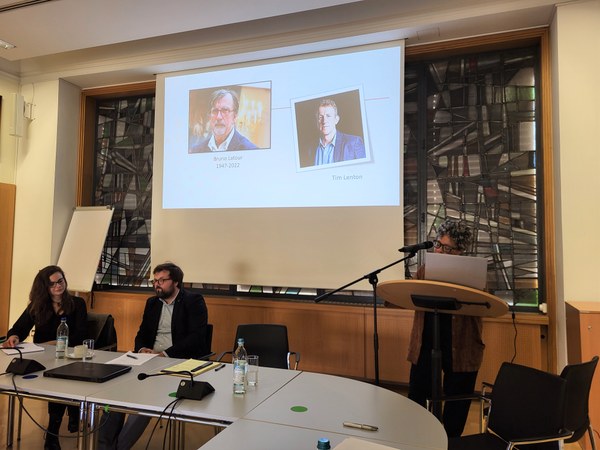
|
|
This year, our fellow Claudia J. Ford’s workshop series “What Earth is Made of” took place on Oct. 18th, and Nov. 10th & 11th, 2022. The series reflected on James Lovelock’s Gaia hypothesis from an indigenous perspective to deepen our understanding of planetary materials and their constellations through art and science. The series connected indigenous ideas about ecology with the climate crisis and engaged the participants in storytelling through all of the senses – hands on farm labor, film, creative writing, lectures, listening, dialog, and an exhibition of climate change and planetary materials inspired visual art.
The workshop series commenced on Oct. 18th with an excursion to JLU’s Gladbacherhof farm. The focus was on one of the most fundamental relationships between humans and the environment – namely food production and nutrition.
On Nov. 10th, Ford delivered a stimulating hybrid lecture on indigenous knowledge and Gaia hypothesis as second event of the workshop series took place. The lecture memorialized James Lovelock (1919 – 2022), who formulated the Gaia hypothesis in the 1970s along with Lynn Margulis (1938 – 2011). Ford reiterated that the earth is a living being in a delicate state of balance and harmony, to whose wellbeing we are all obliged. She also paid homage to the French philosopher and anthropologist Bruno Latour (1947 – 2022), whose ideas resonated with Lovelock’s Gaia theory. Ford raised the point that these esteemed thinkers failed in pointing out that their ideas of the Earth being an interdependent system were not all that new. Predating Lovelock’s considerations by millennia, indigenous thinkers and storytellers have been reflecting on how the earth as a living self-aware system may be capable of feedback and self-correction, especially in its self-regulation of the climate.
Ford emphasized that in the face of the current climate crisis, the stories we tell about ‘nature’ must shift from global to planetary imaginaries. To do so, she called for acknowledging and drawing on existing indigenous knowledge in Western science, as they offer alternative paradigms that are truly transdisciplinary. The extensive bibliography researched for her lecture can be found here.
The lecture was followed by the film screening of the documentary “Inuit Knowledge & Climate Change” (2010), the first ever Inuktitut language film directed by Zacharias Kunuk and Ian Mauro. The film took the viewers on a journey with the Inuit elders and hunters whilst exploring the social and ecological impacts of a warming Arctic. The day wrapped up with an informal gathering at the Planetary Hub where the Panel and the guests closed the evening with vegan fingerfood and pleasant conversations.
On Nov. 11th, Ford conducted a writing workshop to express climate grief through creative arts. Participants got an opportunity to practice creative nonfiction environmental writing using planetary materials, which they found in their immediate environment as prompts. Afterwards, the participants voluntarily shared their pieces of writing with the audience.
In the evening, the workshop series came to a grand conclusion with a festive opening of the exhibition “Planetary Origin Stories”: a collage exhibit at MAGIE - Makerspace Gießen created by Ford during her fellowship. Mehr Impulse opened the reception serenading the event with their melodies, and Ford explained her inspiration behind the exhibit during an artist’s talk. The exhibit was intricately woven around the subject matter of ecological destruction and climate grief (one might consider unpleasant) yet the beauty and finesse of Ford’s pieces paid tribute to the color, shape and form of the natural world and recounted our collective responsibility to safeguard the Earth’s beauty and resources.
Our sincere gratitude goes to Claudia for conceptualizing this multifaceted program, to our keen participants, as well as to Johannes and the team at the Makerspace Giessen for their support to make this workshop series a huge success!

|
 |
November 10, 2022 | Recognizing the 'Resource' as an Active Partner: Report on the Planetary Colloquium Perspectives on the Rights of ›Nature‹
|
In the face of the ongoing loss of biodiversity on the planet, more and more voices are calling for an entrenchment of solid rights of 'nature' within Western legal systems. In our planetary colloquium, questions about whether, how, and why the planet's myriad animal, plant, microbial, and other inhabitants can shape human politics were debated on. In his opening keynote "What rights does nature need?" sociologist Frank Adloff (University of Hamburg) traced the development of different conceptions of rights for animals, plants, and ecosystems. It quickly became clear that Western debates on sustainability, environmental protection, or animal welfare are still far from acknowledging the intrinsic value of non-human life forms. Adloff therefore proposes a "methodological animism": Based on the basic principle of many indigenous cultures, according to which all planetary components are understood as animate and animate, living beings such as worms, mushrooms, or rivers could be programmatically conceived as quasi-subjects. He thus combines indigenous cosmology with a Western understanding of law so that non-human life forms can be grouped together as collective legal subjects. In response to Adloff, sociologist Doris Schweizer (Goethe University Frankfurt) raised concerns about the transferability of human conceptions of law to non-human 'legal persons'. Although she acknowledges the political potential behind the idea, legal systems can only relativize their anthropocentric orientation, never overcome it. Ecosystem researcher Emily Alice Poppenborg (JLU Giessen) followed by raising further doubts: Nowadays, human societies are so closely entangled in the functioning of ecosystems that the term 'nature' is not used at all in Poppenborg's research; moreover, it underpins misguided notions of a nature-culture divide. Nevertheless, lawyer Franziska Johanna Albrecht (Green Legal Impact, Berlin) was able to show that rights of 'nature' - however imperfect they may be - can serve as effective tools in terms of representing non-human interests. As recently as October 3, 2022, the Spanish lagoon "Mar Menor" was declared the first natural legal entity in Europe. Whether this status will actually help the immensely threatened ecosystem out of its crisis remains to be seen and is already questioned by experts (cf. Soro Mateo and Álvarez 2022). In attempts to further refine the concept of nature as a legal entity so that it can be implemented effectively, indigenous models undoubtedly represent pioneers for orientation. Within these attempts, rights of 'nature' can and should by no means be understood as a cure-all against anthropocentrism, but must always be scrutinized as to their motivations. However, as instruments to be continuously further elaborated, they can contribute to the relativization of anthropocentric thinking - and thus perhaps counteract the extinction of species. |
A recording of the hybrid event will be available for streaming on our Youtube Channel shortly.
|
October 27, 2022 - Excursion to the museum Sinclair-Haus
|
On Oct. 27, the Panel visited the Sinclair-Haus, a museum funded by the Kunst und Natur foundation, to see the international exhibition Eternal Ice. The exhibition displayed selected works of contemporary artists who showcased the cultural, political, social and other interrelationships in light of the global ice melt; its effects on local indigenous communities and on the world climate as a whole. The exhibition sent us on a sensorial experience through visual and auditory means that included embroidery, photography and video installations. It showcased work which included (but not limited to) the embroidery work of the Swedish Sámi artist Britta Marakatt-Labba that recounted the (his)stories of Lappish reindeer herders in the far north, a short video collaboration, Rise: From One Island to Another between the Marshall Islander poet Kathy Jetn̄il-Kijiner and the author Aka Niviâna from Kalaalit Nunaat (Greenland). Our special thanks go to Madelaine Heck for providing us with a thought-provoking guided tour of the exhibit! |
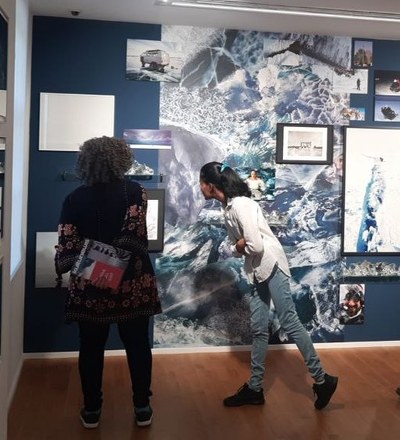 |
Oktober 18, 2022 - Excursion report: Community Farm Day @ Gladbacherhof
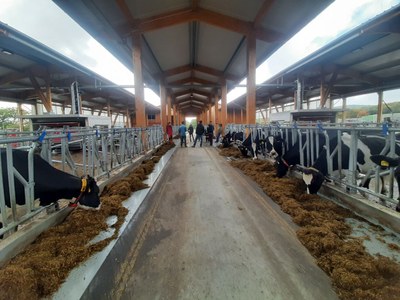
|
|
On Oct. 18, the kickoff event for our Fellow Claudia Ford's workshop series "What Earth is Made of?" took place. The event series serves to rethink the human relationship to the earth and its materialities by combining diverse perspectives from applied fields, science, and the arts. In the first workshop, the focus was on one of the most fundamental relationships between humans and the environment - namely food production and nutrition. To this end, our excursion took us to the Gladbacherhof farm, which combines organic farming and research: on the productive organic farm, research is conducted in cooperation with the JLU to further develop sustainable concepts for organic farming.
The day started with a tour of the newly built dairy cattle research barn, where fully automated milking machines and a fully automated feeding and cleaning system are intended to enable both the study of climate gas emissions in organic farming as part of the Green Dairy project and, in terms of animal welfare, a greater degree of self-determination for the animals.
After a lunch prepared by Veganatural with the farm's own products, the group heard scientific presentations on various topics. In addition to considerations on decision-making criteria for farmers in dealing with sustainable technologies, new approaches in agroforestry and a plea for more care in agriculture were discussed. There was also a tour of the on-site laboratory facilities.
Lastly, the agroforestry techniques discussed in the lecture could be seen in application as Philipp Weckenbrock showed the group around the agroforestry area of the farm. Agroforestry uses a specific planting strategy in an attempt to arrange multiple levels of food production into a single cohesive system. Specifically, the farm's experimental setups are designed to examine the productivity of mixed systems between trees and traditional agricultural crops such as cereals or potatoes. Although they have not been widely used in practice, agroforestry systems promise some advantages, such as greater resilience and resistance to climatic changes, erosion, and increased water storage capacity of the soil.
The field trip allowed us to gain in-depth insights into a fascinating combination of research and agricultural practice in organic farming.
|

|
June 23-25, 2022 - "Planetary Forest - Bring the Forest to the Garden": workshop, vernissage and accompanying exhibition
|
The performative action "Planetary Forest: Bring the Forest to the Garden" from June 23-25, 2022 was the highlight of the first cohort in the Planetary Scholars and Artists in Residence program. This first year of the program centers around the theme "Planetary Materials" and the first Fellows, Claudia Hartl, Clemens Finkelstein, and Mathias Kessler, approached the topic from very different perspectives. As an integral part of trees and thus the forest, wood became the planetary focus material of the semester as well as the central leitmotif for the Planetary Workshop: Led by the Fellows, on Thursday morning a small diverse group explored the planetary dimension of human-forest-climate interactions in the Rosbach City Forest. Clemens Finkelstein, employing a historical and socio-cultural perspective, offered interesting insights into the forest's history of use and the relationship of people to "their forest". Claudia Hartl was able to provide participants with a climatological and dendrochronological point of view: She demonstrated how to take a drill core and used the sample to explain the broad field of tree ring research and the complex relationships between forest health and climate. In addition to sharing knowledge, experiencing the forest and exchanging ideas in and with the group formed a central part of the day. Thus, among others, a member of the local BUND group, an expert in hydrogeology, an employee of the JLU fleet, various colleagues of the department 09, and temporarily even the Rosbach mayor Steffen Maar added to the workshop with their expertise. The latter was available for questions and explained the background of the disturbed area as well as the planned reforestation measures for the site. Afterwards, participants and Fellows alike collected forest material for the living sculpture planned by Mathias Kessler: litter, dead wood, topsoil, roots and even the odd seedling found their way into the trailer. Mathias Kessler also accompanied the trip with his camera and will artistically process the recordings in a short film - soon available on our YouTube channel. On the following day, the Fellows designed the living sculpture as an image of a forest habitat in the Botanical Garden. For now, the fenced-off piece of a disturbed forest site will remain untouched for three years, and its development will be watched expectantly: Will the forest make its way into the garden, will the garden reclaim the area, or perhaps nothing will happen for a while? The sculpture was opened in the festive setting of a vernissage with catering and live music, to which we were also pleased to welcome the President of the JLU, Prof. Dr. Joybrato Mukherjee. In a subsequent article (in German), the Gießener Allgemeine newspaper praised the action for its character as planetary food for thought. We cordially invite you all to visit the living work of art and send dated photos to panel@planet.uni-giessen.de. Experience the Rosbacher City Forest in the Botanical Garden Giessen! For two weeks, the Neuer Kunstverein Gießen e.V. also hosted an accompanying exhibition at its premises, which documented the work of the three Fellows at the Panel on Planetary Thinking. On display were, among others, Line Drawings and "The Arctic Ocean - Failed Hope" by Mathias Kessler, Vibrascapes by Clemens Finkelstein and Dendro Art by Claudia Hartl. We would like to express our sincere gratitude to the city of Rosbach, the forester Eva-Maria Kirchler, the management of the Botanical Garden, the Neuer Kunstverein Gießen e.V. as well as the president of the JLU for their ongoing support in this extensive project! |
|

|

|
May 10, 2022 - First Planetary Lecture on "Planetary Law" by Prof. Dr. Dr. Louis Kotzé and Networking Event of the Panel
|
The Planetary Lecture Series opened with a talk on "Planetary Law for the Anthropocene." Earth System Law pioneer Prof. Dr. Dr. Louis Kotzé (North West University, South Africa) proposed a transformation of international environmental law in order to respond more appropriately to planetary phenomena than has been the case so far: Instead of humans, legal principles should focus on the Earth System, especially in the so-called Anthropocene. Accordingly, Prof. Kotzé centered his lecture around the question how such Earth System Governance could be designed. A corresponding governance approach should emphasize the planetarily significant shaping power of humans, but always relate this power to planetary forces and consider humanity as part of the Earth System. The full recording of the lecture as well as the following discussion opened by Prof. Dr. Thilo Marauhn (Public Law and International Law, JLU) is available on YouTube. The warm spring weather exceeded expectations and set the scene for the subsequent networking meeting of the panel members. The Panel had invited to the new premises to inaugurate the new 'Planetary Hub' and to introduce the current Fellows and their work to the Panel members. First, Geoscientist Claudia Hartl fascinated the assembled with drill core samples of beech trees from the Rosbach city forest and explanations of their history. Colorful, abstract-looking posters formed the centerpiece of Clemens Finkelstein's short lecture on vibrations. The illustrations show the vibration patterns of various ambient sounds of the panel office: Spectators could marvel at the vibratory signatures of church bells across the street, rail traffic behind the building, and a helicopter flying overhead. However, due to its content the demonstration by Mathias Kessler attracted the most attention: the artist presented his work "The Arctic Ocean - Failed Hope", a refrigerator filled with beer. At first glance an invitation to socialize, a 3D version of Caspar David Friedrich's "The Arctic Ocean" lies hidden in the icebox. By opening and closing it time and again, the slight recurring increases in temperature cause the ice to slowly melt. Hereby, Kessler points to the serious consequences that human actions can have on the planet.
|
|
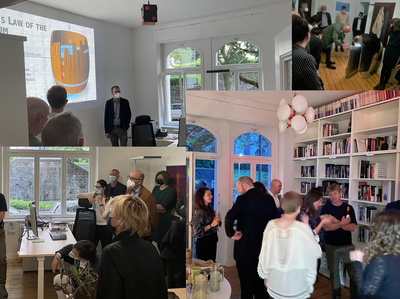
|

|
April 8, 2022 - Field Work in the Rosbach Forest with Claudia Hartl and Lea Schneider
| The Planetary Scholars & Artsists in Residence Program kicks off with the panel team and a small group of students heading to the Rosbach city forest - the fieldwork results in core samples from forty beech trees. In the course of her fellowship project "Tree Ring Reports on Forest Dieback", dendrochronologist Dr. Claudia Hartl investigates the vitality as well as the reactions of healthy as well as dying beech trees to draught events or extreme weather events. Thanks to the active support of Prof. Lea Schneider (Institute of Geography, JLU) as well as her students, ~12,000 tree rings now find their way into Dr. Hartl's long-term study. Although the April weather did not show its friendliest side, the field work turned out an especially instructive as well as memorable event. Beyond the techniques of sampling, the team learned a lot about the many applications of tree-ring research. These range from determining the origin of construction materials, to dating and certifying works of art or musical instruments, to today's widespread research into tree species suitability or climatic change. The annual rings showcase how planetary phenomena, reaching from heat waves to world wars, materialize in locally specific and tangible manners. In addition, the core samples themselves offer a fascinating sight. The beech trees respond to the removal of their valuable cores by creating chemical barriers around the drilling sites and should tolerate the brief procedure well, allowing their vitality to be more accurately determined in the summer based on their by then fully sprouted crowns. News about the unique the unique tree-ring width pattern of the two beech populations in the Rosbach city forest may therefore be expected before long. |
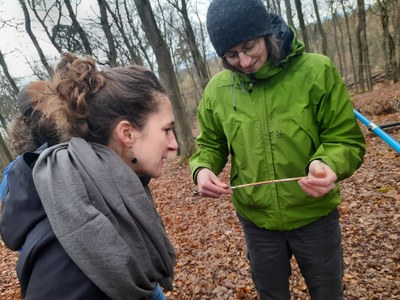
|
June 4, 2021 - Planetary Colloqium "Planetary Perspectives"



